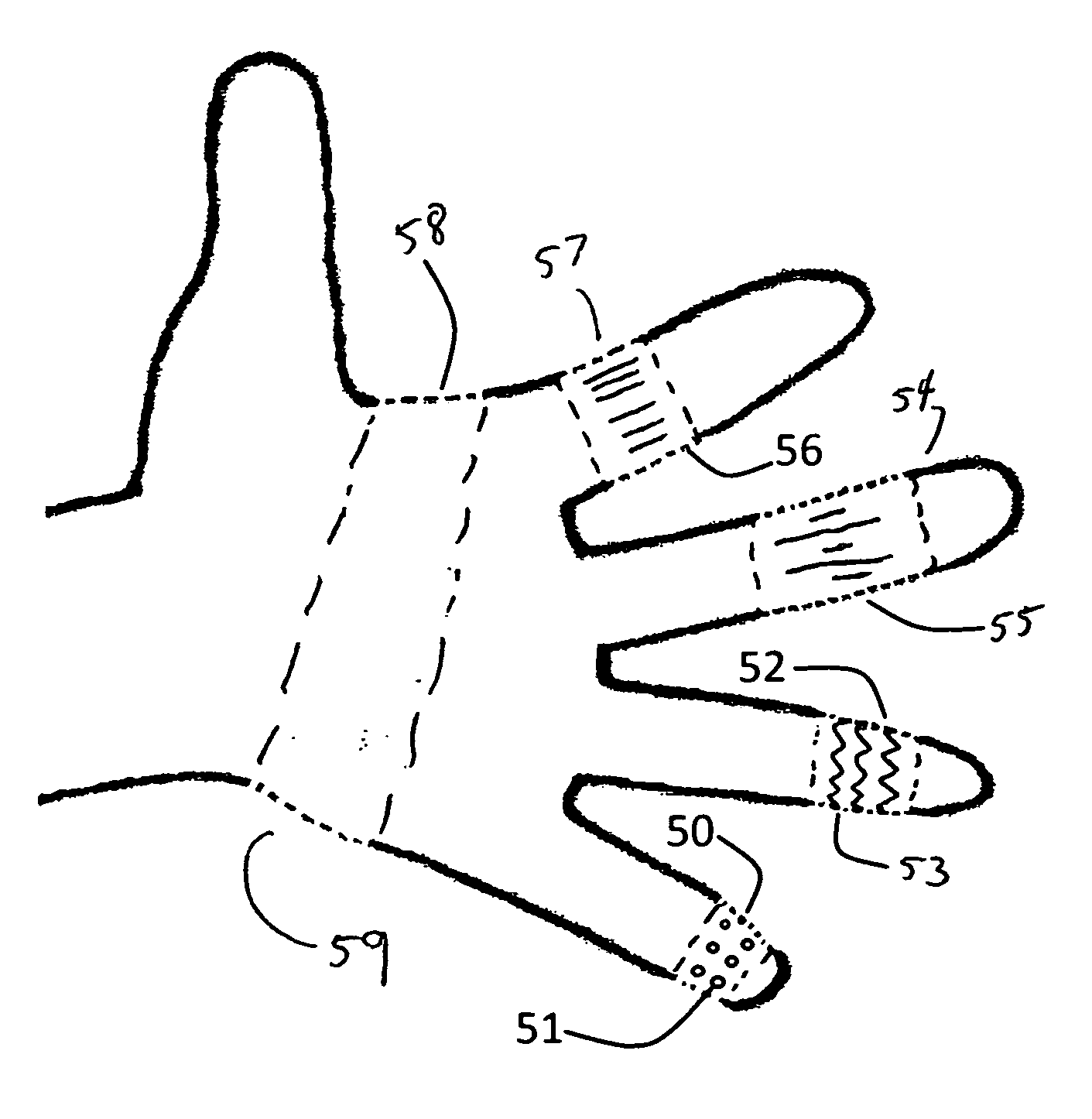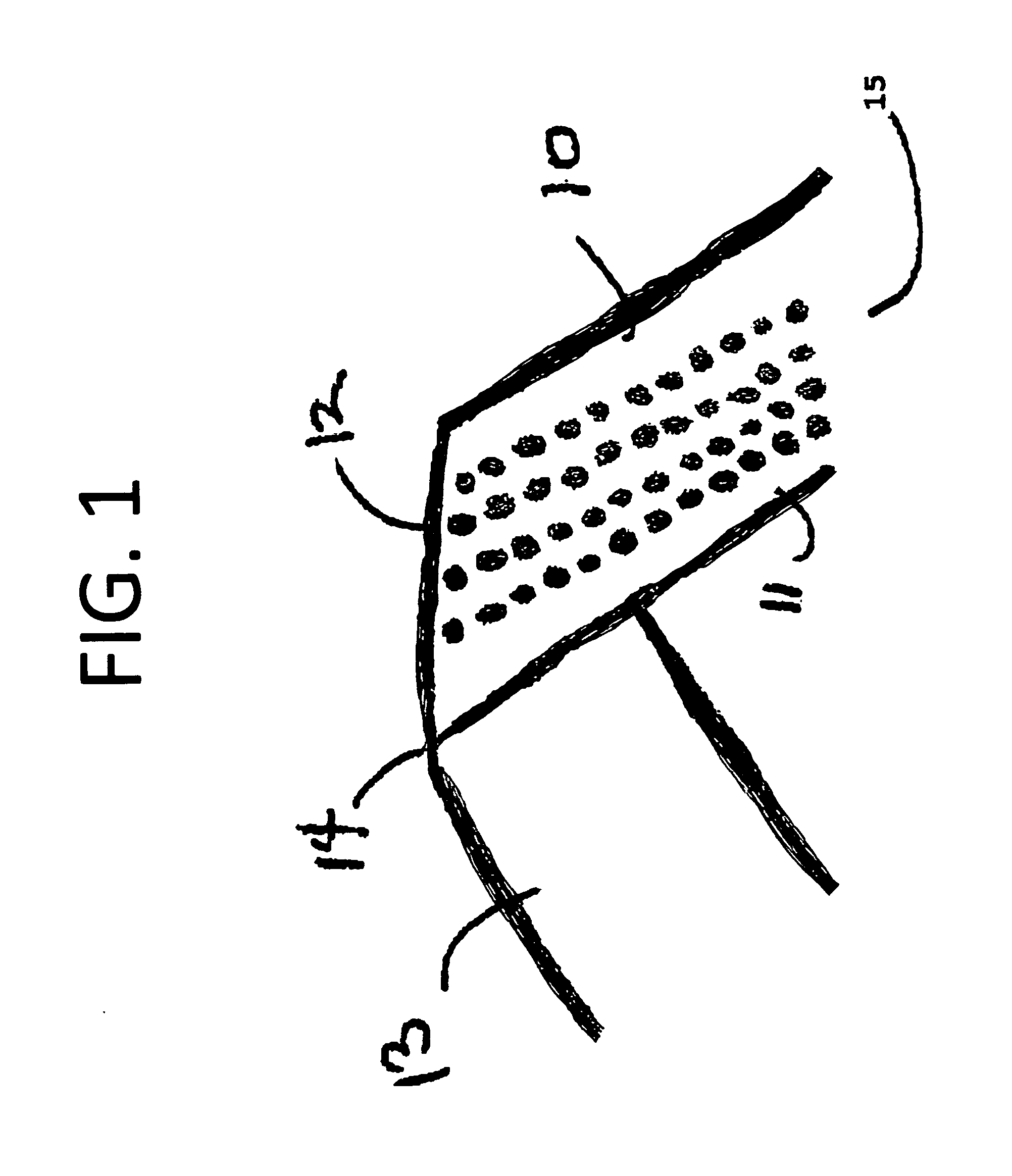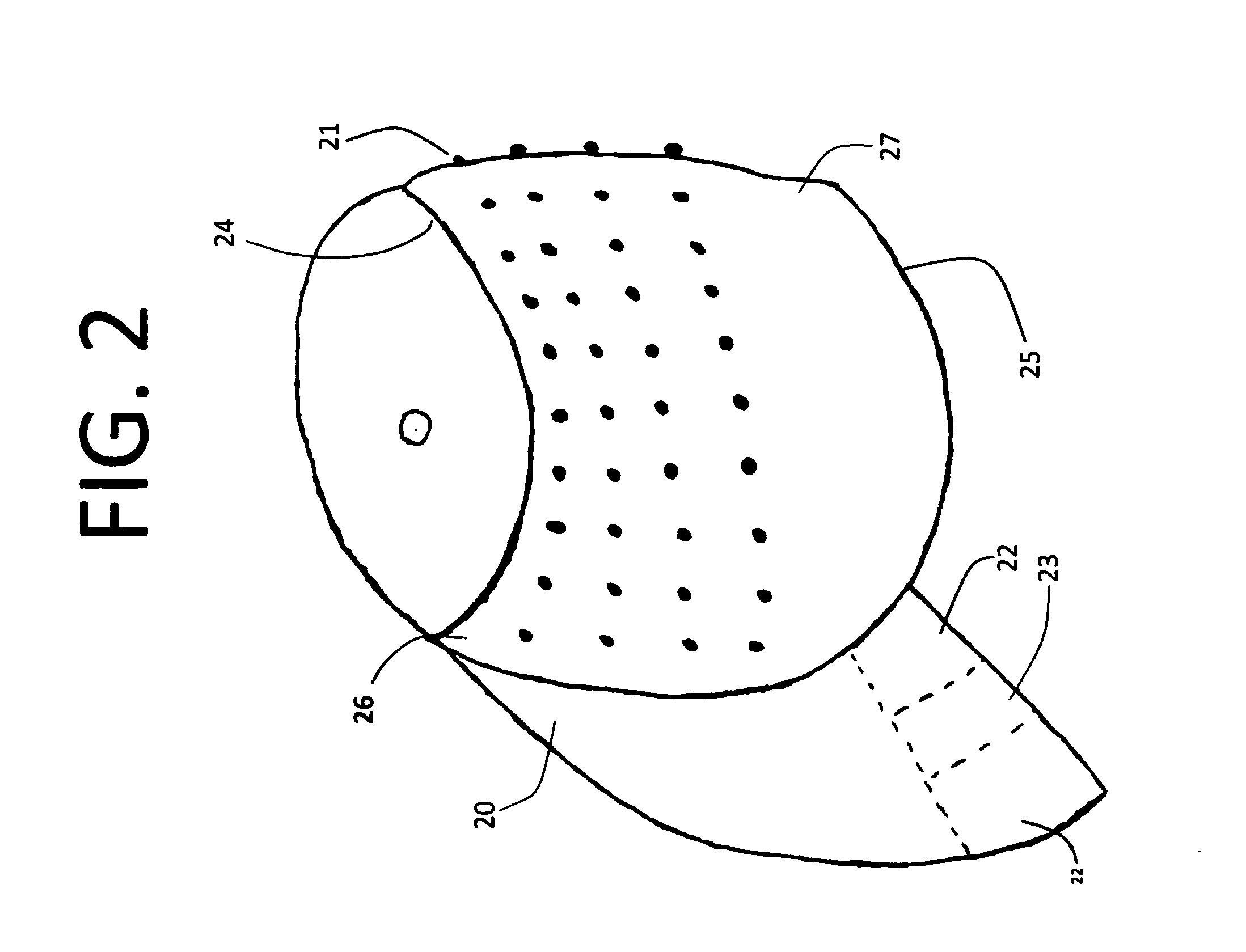Inadequate play execution can result in inconsistencies and turnovers, both long standing problems in many sports, and can often determine the outcome of a game.
Unfortunately, one need only view the statistics to see that fumbles persist as an insoluble problem, even at the professional level today.
Part of the problem lie in the seemingly inherently unstable way a player controls and cradles a ball when running.
Although prior art exists to increase grip around the hand in the form of gloves, these gloves do little to increase ones grip in the general arm area, such as the
wrist,
forearm,
elbow and bicep areas.
Prior art is lacking that enhances the
elbow grip or the
elbow area, an area that plays a significant role in proper play execution.
Additionally, inconsistencies, or incompletes, often arise when a ‘
stress factor’ is introduced once a
receiver first touches and places the ball on their arm area.
This problem is so pronounced that many instant replay situations revolve around seeing whether the ball moves even slightly in the receivers arm—including the forearm which has no real grip enhancers.
Again, because prior art (such as gloves) primarily provides grip enhancing support only around the hands, and not around other areas of the arm responsible for holding and controlling the football from moving, the
receiver can often have great difficulty in keeping the football from moving.
As such, an unrecognized problem currently exists because it is very difficult to grip a ball with parts of the arm.
In football, unstable or weak ball control can, among other things increase fumbles, increase incompletes and thereby increase turnovers and decrease performance.
The ability of the player to maintain control of the football was still problematic because of the lack of any grip enhancing device for the player to use; devices that could be placed on the arm such that the player could now more significantly control a ball with his arm, thereby creating an overall grip of the football throughout the football.
As a result of this unmet need, inconsistencies and turnovers were still high in the sport.
The introduction and subsequent proliferation of the use of gloves found some success but even with these advancements, however, fumbles and incompletes still persist today.
For one, whereas a running back who uses a grip enhancing glove will be better able to properly grip a football by using his hands, his hand, and therefore the grip enhancing device, only cover the front part of the ball, leaving the rest of the ball, and therefore the overall grip, still significantly unstable.
One need only add a
stress factor and this currently unstable hold on the ball can easily result in a fumble.
Unfortunately, significant grip improvements stopped with the hand gloves.
Improvements have lacked in offering a player the ability to achieve an enhanced grip capability throughout the general arm area, where the ball touches the player (such as the forearm, elbow and bicep area).
Improvements have lacked in increasing one's grip around the wrist area (an area that almost always touches the ball when cradling the ball), nor have there been advances to significantly increase ball control around the elbow or bicep areas.
Given the fact that fumbles and incomplete passes persist at the professional level and therefore certainly at the collegiate and amateur levels, one can see that past attempts to solve these problems have had limited success.
Although there are forearm, elbow and even bicep devices that could be used for protection, or simply for aesthetic purposes, no prior art exists that would enhance ball control or grip in said areas.
Unfortunately, this current method of passing a volleyball can provide inconsistent results.
First, the initial contact control is generally with the
skin of the forearm of the player, and without any grip-enhancing device on the forearm, it can become very difficult to redirect a volleyball with consistent precision.
Additionally, a more general reason for inconsistencies is in one's inability to grip with one's forearm.
Without providing the forearm with some way to better grip a volleyball, inconsistencies in the sport of volleyball will continue to be a long-standing problem.
Although offering some advantages, using prior art—such as gloves for the hand—creates disadvantages that often force an individual to choose not to use any grip enhancing device at all.
A result, with prolonged use, often can be the development of
blisters on parts of the hand areas.
The use of gloves has other drawbacks, especially when water is involved.
Unless one buys expensive swimmers-type gloves that are waterproof, one is usually forced to go without any grip enhancers when conducting activities involving water.
Although it does protect ones hand from injury and grime, at times one finds that they have to take off the gloves momentarily, especially during the hot summer months because of the
perspiration building up on the hand from the use of gloves.
This inconvenient and unnecessary problem is created because of lack of ventilation in many
yard gloves.
When the
yard work requires intense activity, then the gloves are worth the hassle, but very often the
yard work is not very demanding.
For example, when one has to control a
shovel or rake, the work is often not very demanding but it is very repetitive.
Another particular area where prior art poses significant disadvantages is in any sport where a player's success depends on her ability to both grip as well as feel a ball or object.
These players often have to choose between wearing a glove thereby enhancing grip but losing significant feel, or going without a glove thereby maintaining maximum feel but missing the opportunity to enhance one's grip.
This is largely because prior art consists of generic full-fingered gloves which are uncomfortable and burdensome on a quarterback's dominant (throwing) hand, particularly on those fingers a quarterback places over the football laces.
Playing the position of quarterback without any grip enhancing mechanism, however, can also be an inferior choice.
Throw the ball at the
receiver.” Whereas, the fingers over the laces have a
solid grip on the ball—primarily due to the football laces on the ball—the two fingers off the laces (forefinger and
thumb) are virtually unsupported and therefore have a relatively weaker grip, creating a weak overall grip on the football.
Also, if one performs a simple test and wets his / her dominant hand, and then grabs and pumps a football, the Forefinger and
Thumb will often move or slip.
On a wet football field, during
extreme weather conditions (hot or cold), that weaker or looser grip makes for a much more difficult completed pass, less success at throwing a spiral, and inconsistency and inaccuracy in passing.
This need to ‘feel’ a ball with a hand has therefore resulted in quarterbacks having to make a difficult choice.
It is no surprise that quarterback fumbles remain a significant problem in football, even at the highest performance levels, and currently remains an insoluble problem in the sport for amateurs and professionals alike.
Additionally, constant swinging of a
golf club at real swing speeds often results in soreness on and between the
Thumb and Forefinger of a golfer's strong hand (wearing no glove).
This is especially important in the sport of golf because even the smallest of slipping—during the golf swing or upon
impact of the
golf ball—can create enormous inconsistencies and inaccuracies, critical issues in determining overall performance.
Although there are several multisport gloves in the market today, virtually no one uses gloves when playing basketball.
Although many hand tasks require a good grip, no art currently exists that would provide these players with enhanced grip capabilities or enhanced protection by being able to cover only select parts of the hand, without having to sacrifice the critical feel ability along other parts of the hand.
Prior art is lacking that would provide an athlete with the ability to have enhanced control when dribbling a basketball.
Without any extra grip-enhancers however, it is difficult to maintain stable control of the basketball.
For Forwards and Centers especially, this hand task can quickly take a
toll on their fingers if their fingers are not somehow protected.
This current method and product has significant shortcoming that often result in inferior execution.
For example, if one tapes parts of ones hands with the prior art, they will lose any grip capabilities in that area, which could then result in mishandling the basketball (a significant issue with Forwards and Centers).
In this situation the player has to tape their hand (or wear some sort of medicated
bandage), especially when injuring a finger.
The result again is a decrease in ball control and limited protection.
Loss of dribbling control often results, as does loss of ball control when preparing to
shoot the ball (as seen when the ball slips out of the players hand and flies up in to the air as they are shooting the ball).
If a player injures herself, the player will have diminished gripping capabilities if she uses prior art to cover and protect that injury.
Injuries can result when limbs are bent beyond the natural elastic limitations of tendons and muscles.
 Login to View More
Login to View More 


